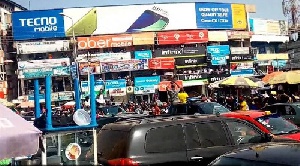Vehicular transport in Ghana has grown with economic activity and ever-increasing car ownership levels. The demand has increased because of the urban sprawl, the evolving services sector, lack of a reliable public transport system and the Ghanaian mentality which sees car ownership as a status symbol (it is common to hear people boasting that they own five expensive cars). With so many cars and trucks on our roads, the motor vehicle has become a fact of life for Ghanaians. But our reliance on them comes at a cost. Many have died or sustained serious injuries in traffic accidents.
The number of articles in the Ghanaian newspapers, on Ghanaweb and contributions on talk back radio following the death in recent times of the three urologists and other high profile individuals is enough evidence of the cost to the country both in economic, human and social terms of deaths and injuries caused by road accidents. It is in this context that I read with interest the Government?s enactment of a new Traffic Act: Road Traffic Act 2004, Act 683 (Act 683). I called for such an Act in my article: It is Time: Reducing Accidents on Ghanaian Roads (Ghanaweb 2003-10-28) because it is imperative that bad driver behaviour is tackled on every front with dangerous drivers punished. Legal sanctions are therefore an essential element in the process of changing driver behaviour. The enactment of the legislation in the form of Act 683, though in my view overdue, is a step in the right direction. I do not have access to the legislation in its entirety but the snippets I have read are in line with some of the suggestions I made in my article referred to earlier. Let me remake the point I made sometime ago that legislation alone is not the answer to reducing accidents on Ghanaian roads.
In my view there are a number of important factors that influence prevention and reduction of road accidents. Legislation is only one of them0. Other factors include environment/engineering, education and enforcement. I propose to briefly look at these factors in the context of Act 683.
Enforcement
Act 683 will be successful if it creates a meaningful deterrent threat to road users. To be effective there must be a significant increase in the actual level of enforcement. There is no doubt that one of the best measures that ensure success of enforcement action in traffic matters is increased surveillance and periodic road blitzes. In Ghana, there is high visibility of police on our roads but this only has a minimal effect on actual road user behaviour because the police are looked at as people who harass people and who take bribes and leave the offending driver to continue with the bad behaviour. This perception is evident in the statements made by striking tro tro drivers in Takoradi (Ghanaweb 4 Oct 2005). The result is that instead of the high visibility of the police on our roads leading to increasing penalty severity and the quick and efficient administration of punishment to further enhance the deterrent effect, the enforcement regime is seriously undermined. If we are to make a head way with enforcement we need to reduce the size of enforcement tolerance levels to ensure greater adherence to the law and this is where the police and courts come in. There will be some stiff opposition to the strict enforcement regime and the imposition of fines on offending drivers (see Ghanaweb Oct 4 2005), but the police and the courts must continue to enforce the law without fear or favour if we are to change road user behaviour.Drink driving
The legislation also refers to prosecution for drivers with blood alcohol levels over the prescribed limit. For this measure to be effective there should be many random breath testing (RBT) activities on our roads whereby a large proportion of drivers are stopped at random and ALL are tested for alcohol impairment. RBT should be visible and accompanied by sustained high levels of publicity. Commitment to RBT is essential if we are to reduce the level of alcohol related accidents on our roads. We must ensure that if a person fails a roadside blood test they are not allowed to continue driving. In Australia, you are not allowed to drive if you fail the blood alcohol test but are taken to the nearest police station for further blood alcohol tests and if the roadside test is confirmed, you are charged with drink driving and have to appear before a magistrate within a short time which could be the same day depending on how far above the limit you are or within a month. Most people arraigned before the courts on drink driving charges get a fine in addition to their licence being suspended or cancelled for a mandatory minimum period of three months. Only few have their offences proven but have no conviction recorded against them. Such persons must have had a very clean driving record of over 20 years in addition to the offender being able to argue that there were compelling and exceptional circumstances.
Environment/engineering solutions
The other measures that need to be taken if we are to reduce the high incidence of accidents on our roads are examining the environment/ engineering aspects of our road network, education of road users and the provision of reasonable levels of resources to support the enforcement regime and education activities.
General design of roads is very important. I have seen a research paper which suggests that poor road design contributes to about 30 per cent of road accidents. We need to ensure that design and construction of new road are to best practice standards if we are reduce road accidents and fatalities. In relative terms the better safety record of motorways and dual carriageways is evidence of the importance of road design. In Ghana, there are hardly any overtaken lanes where drivers can safely overtake on our single lane carriage ways. Drivers rely on the vehicle in front to indicate when the vehicle following can safely overtake. Sometimes the sign to the driver behind to overtake is given on a crest of a hill or too late and this could result in an accident or a near miss. Improved roads, maintenance of existing roads and the elimination of traffic congestion black spots contribute to a more efficient transport system.
Accident investigation
In addition to constructing improved roads we need to have better accident investigation units. The use of tape measures and chalk at the scene of accidents should be replaced by better methods whereby accident locations on road networks are investigated. The investigation should look at some of the following issues: condition of the vehicle(s) involved, conditions at the time of the accident; time of day; driver behaviour behind the wheel, including issues relating to driver fatigue; experience of the driver(s), road signs; location of accident; how many accidents have occurred at that spot etc. The purpose of this exercise is to pin point the cause of the accident and identify risk factors. It will enable preventative measures to be developed. For example, if a particular spot is identified as being prone to accident, appropriate remedial countermeasures must then be implemented eg a speed calming device may be provided or the road realigned. The remedial strategy also required an evaluation of the effectiveness of previous remedial measures eg the speed calming device adopted may not be appropriate and an alternative speed calming device may be needed.
Road signs
To reduce accidents on our roads, we need clear, logical road direction signs. A lot more thinking needs to go into how direction signs are laid out, located and lead the driver confidently to their destination. In many cases road signs are non existent or where they exist they are badly placed or not illuminated or may even point in the wrong direction.
Education/publicity
Enforcement should not be relied upon as the sole means of reducing traffic accidents. Enforcement, good roads and good road signs should be supported by high levels of public and driver education and program evaluation. Publicity and education are essential requirements to raise community awareness and improve the effectiveness of enforcement operations. It is essential that road users actually observe the publicised increase in the level of enforcement activity otherwise behavioural changes may only be short-lived.
Special consideration should be given to the use of police education programs to educate police on the safety and cost benefits associated with enforcement operations. Sustained public awareness campaign and information dissemination must be undertaken. Road safety must be made an integral component of driver training. Public education plays a big part in educating the driver on safety and getting the driver to obey the traffic laws. There will always be people who will drive recklessly but it is important that the community gets involved in this area and not tolerate bad driver behaviour.
Road users must be educated on the importance of wearing seat belts. It would be good if all cars, taxis and mini buses have seatbelts in them and that people actually wear them. The number of cars I see without seat belts means extra effort must be put into educating both drivers and passengers of the safety aspects of seat belts. Pedestrians and people on motor bikes, and bicycles should wear brightly coloured clothes at night. There is research evidence that this helps in reducing accidents involving motor bike riders and pedestrians. The appalling standard of driving in the country needs addressing. Better driver training may help. Drivers should be educated to drive according to the conditions Inappropriate speed for the conditions can mean that 20kph in certain conditions may be too fast. At the same time too slow a speed can also cause serious accidents. Tail-gating is at least as dangerous as speeding, but seems to be completely unknown as an offence in Ghana and therefore not enforced. Why is there such a blind spot about safe distances? Drivers should also have lights on after dusk. There are instances where vehicles are driven without lights for long distances. The use of hand held mobile phones while driving should also be made a traffic offence. Maintenance In my view the neglect of the maintenance of vehicles is one of the major reasons for accidents on our roads. Some of the vehicles especially the tro tros and taxis are death traps on the road with poor brakes, bald tyres and poor lights. There is a need to find an effective means of ensuring that vehicles are road worthy. Vehicles found not to be roadworthy should be taken off the roads. In Canberra, there is random vehicle inspection. Inspectors inspect cars even at car parks. Vehicles found to be defective are issued with a defective sticker which requires the defects to be repaired and then taken to a vehicle inspection centre for clearance before it is put back on the road. Drivers and owners of vehicles should also not be maintenance misers for a stitch in time always saves nine. Resources Finally, traffic law enforcement has high costs associated with it and I am not sure of the steps that have been taken or are being taken to address the resource issues that the legislation throws up. How many breath testing equipment have been provided to police? How much training on the use of this equipment has been provided to police? How many efficient and effective police are available for enforcement action? What is the allocation for the provision of education of road users on the law and what strategies are in place to ensure the programs effectives? How much money has been allocated for implementation of the program?
Conclusion
We need to put road safety high on the agenda and adequately resource it. It is time to act and the conditions are good for an effective road user education campaign.















